
Hornets are the largest of the eusocial wasps, and are similar in appearance to their close relatives yellowjackets. Some species can reach up to 5.5 cm (2.2 in) in length. They are distinguished from other vespine wasps by the relatively large top margin of the head and by the rounded segment of the abdomen just behind the waist. Worldwide, 22 species of Vespa are recognized. Most species only occur in the tropics of Asia, though the European hornet, is widely distributed throughout Europe, Russia, North America, and Northeast Asia. Wasps native to North America in the genus Dolichovespula are commonly referred to as hornets, but are actually yellowjackets.
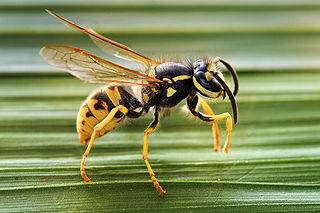
The Vespidae are a large, diverse, cosmopolitan family of wasps, including nearly all the known eusocial wasps and many solitary wasps. Each social wasp colony includes a queen and a number of female workers with varying degrees of sterility relative to the queen. In temperate social species, colonies usually last only one year, dying at the onset of winter. New queens and males (drones) are produced towards the end of the summer, and after mating, the queens hibernate over winter in cracks or other sheltered locations. The nests of most species are constructed out of mud, but polistines and vespines use plant fibers, chewed to form a sort of paper. Many species are pollen vectors contributing to the pollination of several plants, being potential or even effective pollinators, while others are notable predators of pest insect species.

Vespula is a small genus of social wasps, widely distributed in the Northern Hemisphere. Along with members of their sister genus Dolichovespula, they are collectively known by the common name yellowjackets in North America. Vespula species have a shorter oculomalar space and a more pronounced tendency to nest underground than Dolichovespula.

Paper wasps are vespid wasps that gather fibers from dead wood and plant stems, which they mix with saliva, and use to construct nests made of gray or brown papery material. Some types of paper wasps are also sometimes called umbrella wasps, due to the distinctive design of their nests.
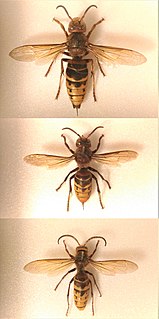
The European hornet is the largest eusocial wasp native to Europe. It is also the only true hornet found in North America, having been introduced by European settlers in the 1800s. Vespines, such as V. crabro, are known for making intricate paper-like nests out of surrounding plant materials and other fibers. Unlike most other vespines, reproductive suppression involves worker policing instead of queen pheromone control, as was previously thought.
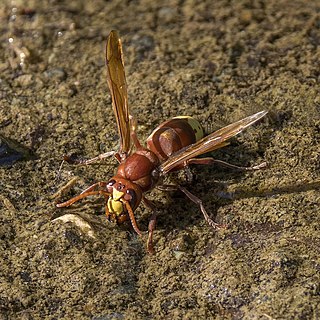
The Oriental hornet is a social insect species of the family Vespidae. It can be found in Southwest Asia, Northeast Africa, the island of Madagascar, the Middle East, Central Asia, and parts of Southern Europe. Oriental hornets have also been found in a few isolated locations such as Mexico and Chile due to human introduction. The Oriental hornet lives in seasonal colonies consisting of caste system dominated by a queen. The hornet builds its nests underground and communicates using sound vibrations. The hornet has a yellow stripe on its cuticle (exoskeleton), which can absorb sunlight to generate a small electrical potential, and this might help supply energy for digging. The adult hornet eats nectar and fruits and scavenges for insects and animal proteins to feed to its young. Because they are scavengers, the hornets may also serve as a transmitter of disease following consumption of infected plants. The hornets are a primary pest to honey bees, attacking bee colonies to obtain honey and animal proteins. The sting of an Oriental hornet can be quite painful to humans and some humans are allergic to stings.
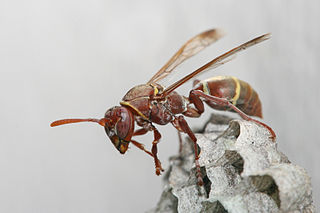
The Polistinae is a subfamily of eusocial wasps belonging to the family Vespidae. They are closely related to the more familiar wasps and true hornets of the subfamily Vespinae, containing four tribes. With about 1,100 species total, it is the second-most diverse subfamily within the Vespidae, and while most species are tropical or subtropical, they include some of the most frequently encountered large wasps in temperate regions.

Dolichovespula is a small genus of social wasps distributed widely throughout the Northern Hemisphere. The yellow and black members of the genus are known by the common name yellowjackets in North America, such as Dolichovespula norwegica, along with members of their sister genus Vespula. In a study on the nesting biology of Dolichovespula, a colony of D. maculata with 771 workers was reported as having the largest recorded population count.

The Stenogastrinae are a subfamily of social wasps included in the family Vespidae. They are sometimes called hover wasps owing to the particular hovering flight of some species. Their morphology and biology present interesting peculiarities.

Vespa simillima, the yellow hornet, including the color form known as the Japanese hornet or Japanese yellow hornet (キイロスズメバチ), is a common hornet species in the Eastern Hemisphere. The typical mainland color form is darker and hairier than the yellow form; it lives in Hokkaido, the Korean Peninsula, Eastern Siberia and China, but is less common in Japan, where the yellow color form predominates. It should not be confused with the Asian giant hornet, which has a color form sometimes referred to as the "Japanese giant hornet". While there is a history of recognizing subspecies within many hornets, the most recent taxonomic revision treats all subspecific names in the genus Vespa as synonyms, effectively relegating them to no more than informal names for regional color forms.

Dolichovespula adulterina is a species of parasitic social wasp found in the Palearctic region. D. adulterina feeds on a variety of foods, including insects, spiders, arthropods, meat, molluscs, fruit, nectar, and larval secretions. D. adulterina was formerly considered to be synonymous with D. arctica from the Holarctic region, but more recent research indicates that D. arctica is a separate species.

The Central American paper wasp is a nocturnal eusocial wasp. It is famous for its swarm based emigration behavior, and is native to the lowlands of Central and northern South America. This species has developed special night vision adaptations to facilitate their night-time swarming and foraging behavior and has important medicinal properties for the Pankararú people of Brazil.
Apoica flavissima is a paper wasp found primarily in South America. The species is distinguishable by its light coloring, unique single comb nests, and nocturnal nature. A notable feature of this species is the size dimorphism between queens and workers. Unlike most Vespidae wasps, Apocia flavissima queens are smaller than their worker counterparts which results in unique intraspecies relationships.

Dolichovespula arenaria, also known as the common aerial yellowjacket, sandhills hornet, and common yellow hornet, is a species of wasp within the genus Dolichovespula widely distributed in the North American continent.

Polybia sericea is a social, tropical wasp of the family Vespidae that can be found in South America. It founds its colonies by swarming migrations, and feeds on nectar and arthropods.
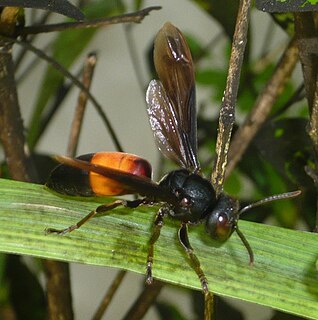
Vespa affinis, the lesser banded hornet, is a common hornet in tropical and subtropical Asia.

Vespula vidua, known generally as the long yellowjacket or widow yellowjacket, is a species of stinging wasp in the family Vespidae.

Vespula consobrina, the blackjacket, is a species of stinging wasp in the family Vespidae.
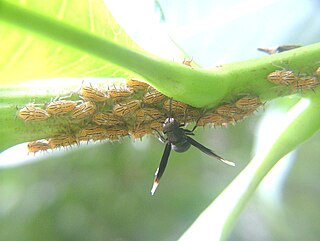
Parachartergus is a genus of epiponine social wasps belonging to the subfamily Polistinae. Species include:
Van der Vecht's gland or Van der Vecht's organ is a gland which is located in an area of modified cuticle on the rearmost gastral sternite of female wasps. This gland secretes chemicals which are important in the determination and maintenance of the hierarchy of groups of eusocial wasps and are used in the defence of the nests in others. In the Asian giant hornet the van der Vecht's gland is used to scent mark hives of honey bees to attract other members of their colony to cooperatively attack the hive the only known case of the gland's use to scent mark a food source. In the cleptoparasitic paper wasp Polistes semenowi the female usurps the host foundress, usually Polistes dominula and uses an enlarged Van der Vecht's gland to produce large quantities of hydrocarbons and to control the host workers, and even sometimes the host foundress. The gland was discovered by, and named in honour of, the Dutch entomologist Jacobus van der Vecht.


















